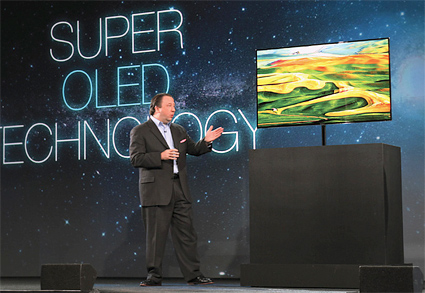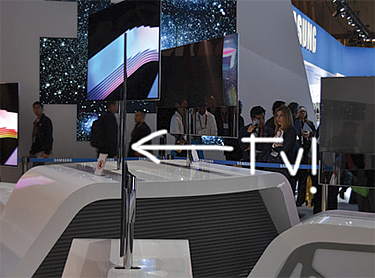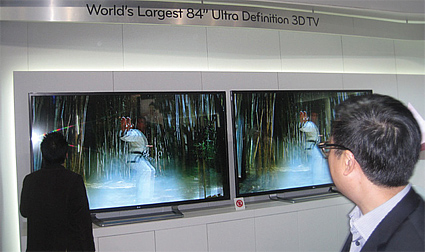CES: What's New Is OLED
LAS VEGAS -- Whether it was LG's "ultra-definition" 3DTV or Sony's "Crystal LED" 55-inch flat-panel prototypes; Motorola's Xyboard and Droid tablets or Huawei's ultra-skinny Ascend smart phones; DISH's "Hopper" or "Channel Master TV" (actually an over-the-air tuner with a built-in Web connection), the array of options at this year's International Consumer Electronics Show (Jan. 10–13), augured acceleration of the TV industry's new agenda.
Samsung wowed CES attendees with its 0.3-inch deep 55-inch Super OLED display. Photo by Samsung Tomorrow Almost every year, CES promoters vow that the current crop of new products will launch the audio-video and online world into important new trajectories. This year, with record-breaking attendance of 153,000 people and 3,100 exhibitors—both figures are 10 percent above initial estimates—the hype may be reasonable, depending on the economy's ability to absorb so much innovation.
THIN & SMART
Not only were TV monitors vaster and thinner than ever, but the alternative delivery options continued to expand. Internet-delivered video to "smart TVs" was omnipresent, with special emphasis on wireless options for tablets and smartphones, which in turn triggered new episodes in the battle of the airwaves. The profusion of health/wellness monitoring and other devices that require machine-to-machine (M2M) connections raised further concerns about how to assure sufficient wireless spectrum.
Amid the technology avalanche, there was time for self-reflection, notably Best Buy CEO Brian Dunn's confession about the floundering 3DTV rollout. "I don't think the story was told as effectively as it could have been," Dunn said in a keynote presentation. "Content's got to be out there to pull this wagon." He suggested the 3D situation will become "much more interesting" when glasses-free 3D arrives, which could be very soon, based on exhibits from Sony, LG, Toshiba and many others.
While 3D hovers, CES's major focus was on the growing presence of Organic Light Emitting Diode (OLED) displays and the following generation of technology, especially Sony's ultra-bright Crystal LED device. Just two years ago, TV makers were struggling to deliver OLED screens larger than 25-inches. This year, dozens of OLED screens in the 50-inch and larger range were on displays, although pricing information is still sparse.
LG's booth—the first thing many CES visitors saw when they entered the main exhibit hall—featured Cinema 3D exhibits plus an array of next-generation video options. Its 84-inch 3D Ultra Definition TV delivers 8 million pixels, four times the resolution clarity (3840x2160) of existing conventional HD panels. It also features 3D "Depth Control," which allows users to customize the 3D effect.
Photo by CEA/International CES At the other end of the floor, Sony showcased its 55-inch Crystal LED prototype, which uses about six million LEDs to create a full HD display, which can be seen at a nearly 180-degree viwewing angle. Sony says the display is at least two years away—and other sources suggest that the manufacturing price may be prohibitive for longer than that period.
DISH introduced "Hopper," which features a two terabyte (2,000-hour capacity) digital video recorder with whole-home distribution capability. DISH will ally with ViaSat for satellite broadband service, integrating online video with linear and on-demand programming. Channel Master unveiled a two-tuner ($399) receiver along with an Ethernet connection and built-in VUDU connection to allow viewers to see and store broadcast plus Web video content.
MORE MOBILITY
CES's TV array was not just about size and visibility. Increasingly, the focus was on interconnectivity and multiscreen capability, with Samsung gloating that by the end of this year its sets will offer 1,500 video apps, (global number, not all available in the U.S.). Sony, Samsung, Toshiba, Vizio and others that make both TV sets and tablets showcased integrated systems that allow the mobile devices to integrate with—and often serve as a dynamic remote control for—the TV sets.
Separately, Mobile DTV's trudge toward reality continued, much of it centered around a CES pavillion of about a dozen vendors showing off everything from chips (Siano Mobile Silicon) to video clips (Dyle, the new content service from the Mobile Content Venture).
"Reaction to the Mobile DTV TechZone and new Dyle products from Samsung, Belkin, and RCA show that there is high interest in real TV on-the-go," said Anne Schelle, executive director of the Open Mobile Video Coalition, which coordinated the showcase. "Technology demonstrations during CES showed what's coming, including Mobile Emergency Alerts from the Las Vegas PBS station." (KLVX-TV is one of the pilot broadcasters showing the capabilities of Mobile DTV to assist in emergencies.)
Another cross-over service, "Syncbak," which has drawn financial support from the National Association of Broadcasters and the Consumer Electronics Association, marked a watershed moment during CES. "We transitioned from technology company to consumer company with our mobile and Smart TV offerings," said Jack Perry, CEO and founder of the Marion, Iowa-based company. "There were several times during the show where we had both broadcasters and CE manufacturers in the booth talking about television over-the-top, or OTT. Our first market, Spokane, Washington, goes live later this month where we have three of the four major network affiliates set up and ready to go."
LG's new 84-inch Ultra-Definition 3DTV boasts native resolution of 3840 x 2160 pixels, for a total of about 8 million pixels. Photo by Gary ArlenCONTROL, CONTENT & BANDWIDTH
Call it "son-of-SIRI," a follow-on to the engaging voice-response technology that is part of the Apple iPhone 4S. Although voice-activated remote control prototypes have been demonstrated for more than a decade, several voice-control technologies appear closer to market. Active Video Networks, which announced a deal with Cisco's VideoScape system, also showed a voice-control system that actually piggybacks on the iPhone SIRI technology.
Haptic and gesture controlled remote control systems were also embedded in more TV systems, such as the LG "magic wand" control that uses Hillcrest Labs' technology.
Other approaches to viewer control include Automated Content Recognition (ACR), which is envisioned for applications ranging from social TV and personalized viewing recommendations to ad responses and audience measurement. Audible Magic, a digital fingerprinting provider that is active in the ACR category, unveiled plans to provide services on live TV shows, which Jay Friedman, the company's marketing vice president, claims will "integrate a new advertising experience."
As the gizmos' capabilities increase, there is growing recognition of viewers' appetite for more content. During a keynote speech for the CES "Entertainment Matters" conference, Robert Kyncl, vice president of global content partnerships for YouTube, focused on the rapid growth of Internet video's "channel model." Kyncl pointed out that YouTube's five most viewed channels have as many viewers as the top 20 cable channels.
Such discussions tied into the challenge looming over the entire CES show: availability of bandwidth. FCC Chairman Julius Genachowski, in an on-stage discussion with CEA President/CEO Gary Shapiro, was in full campaign mode to promote his National Broadband Plan, emphasizing that in the evolving broadband ecosystem, "Everything is connected wirelessly."
"We should work on unleashing more of it [spectrum]," Genachowski said, concluding that he is proud that his legacy at the FCC will be "that we focused on broadband."



Get the TV Tech Newsletter
The professional video industry's #1 source for news, trends and product and tech information. Sign up below.
Gary Arlen, a contributor to Broadcasting & Cable, NextTV and TV Tech, is known for his visionary insights into the convergence of media + telecom + content + technology. His perspectives on public/tech policy, marketing and audience measurement have added to the value of his research and analyses of emerging interactive and broadband services. Gary was founder/editor/publisher of Interactivity Report, TeleServices Report and other influential newsletters; he was the long-time “curmudgeon” columnist for Multichannel News as well as a regular contributor to AdMap, Washington Technology and Telecommunications Reports; Gary writes regularly about trends and media/marketing for the Consumer Technology Association's i3 magazine plus several blogs.

